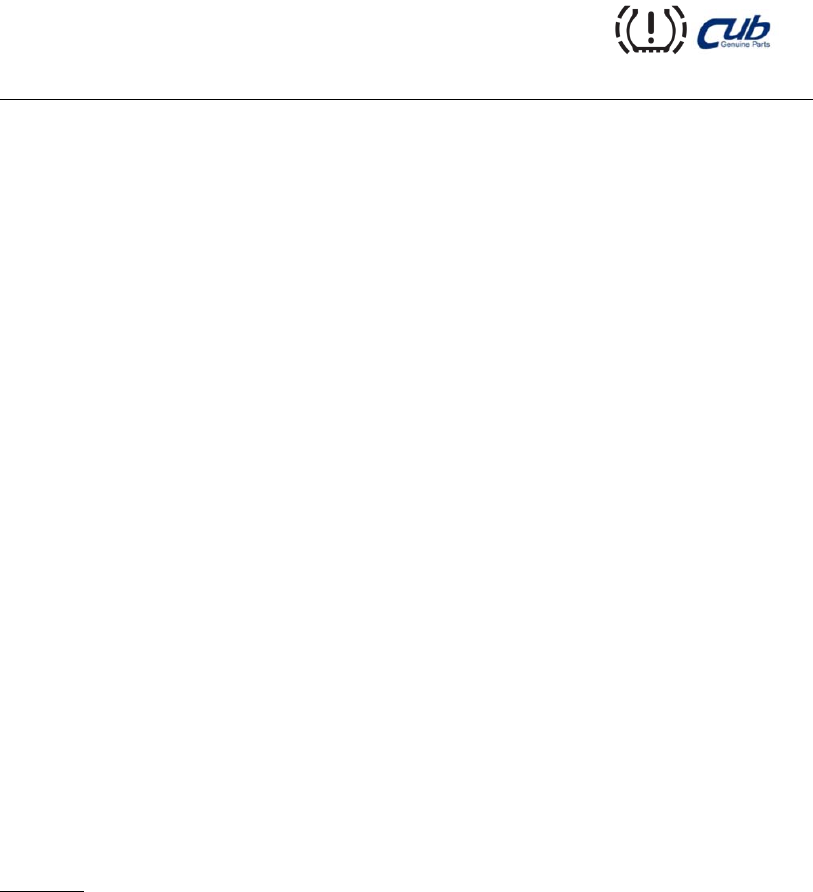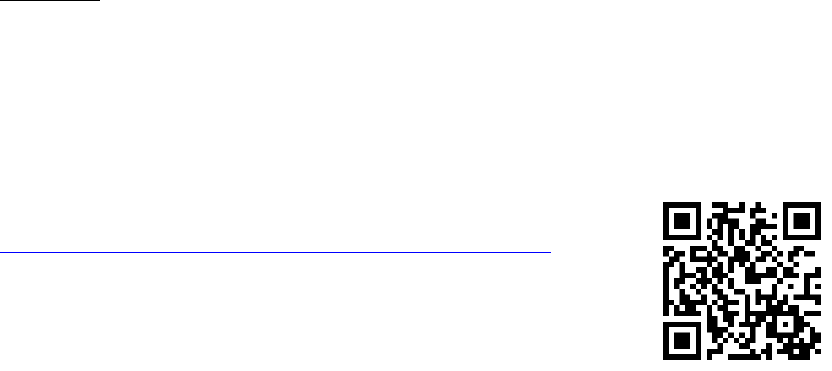CUB ELECPARTS UNI-SENSOR TIRE PRESSURE MONITOR SENSOR- C (433MHZ) User Manual
CUB ELECPARTS INC TIRE PRESSURE MONITOR SENSOR- C (433MHZ)
User manual

UNI‐SENSORInstallationInstructions
AfteryouhaveprogrammedtheUni‐Sensor,followinstallationproceduresbelow.
ForClamp‐InMetalValveSensors:
1. Insertvalvestemgrommetonto
stemwithlargestdiameteragain
valvestembody.
2. Placevalvestemintosensor.Loosely
screwintoplacesosensordrop
anglecanbeadjusted.
3. Insertassembledsensor&valve
stemintowheel.Holdinplaceby
hand.
4. Fromoutsidewheel,putonwhite
seal,thenmetalwasher,thenvalve
stemnut.Whileholdingsensor
downagainstwheelbottom,hand
tightennut.Withtorquewrench,
tightenValveStemNutto4.5Nm.
5. Holdingsensordownagainstwheel
bottom,withtorquewrench,tighten
valvestemscrewto4.0Nm.
6. Doublecheckallwork.
ForRubberSnap‐InValveSensors:
Avoidwetandextremetemperatures.
Neverinstallausedscreworused
Snap‐inValve.
1. Applytiresoaporlubesolutionto
rubbervalvestem.
2. Linesensorupwithrimholeand
attachastandardTTVpulltoolto
theendofthevalve.
3. Pullthevalvestemstraightthrough
thevalvehole.RefertoyourTTV
toolmanualforproperinstallation.
4. Refertoyourtirechanging
equipmentmanualsforproper
instructionsformountingtiretorim
whensnap‐inTPMSsensorsare
used.
5. Prohibiteduseforracingand
beyond180km/h(110mph).
6. Tightenthescrewby12lbf‐inif
necessarytoreinstallthevalve.
Caution:
Itisrecommendedtoseektheserviceofaqualifiedtechnician.Payspecial
attentionandfollowallinstructionstoallcautionsandwarningsincludedintheshop
manual.Failuretodosocouldresultinfailureofthevehicle’sTirePressureMonitor
System(TPMS)Sensorstofunctionproperly,orresultindamagetotheTPMSSensor.
ThePUR‐sensor(Uni‐Sensor)isblanksoftwareinside,besuretoprogramthe
sensorbyCUB’ssensor‐AIDorcompatibletoolforyourspecificmotorvehiclemake,
modelandyearbeforeinstallation.OnlyinstallprogrammedTPMSsensorstothe
applicationlistedinthetool.ImproperTPMSinstallationortheuseofunauthorized
TPMSSensorswillcausethefailureofTPMsystem.Uponcompletionofinstallation,
testtheTPMSSystemfollowingtheoriginalmanufacturer’sserviceguidetoconfirm
properinstallation.Checkallinstallationprocedurestoensureproperinstallationand
retest.IftheSystemcontinuestofailconsultwithCUBsupportoranauthorized
motorvehicledealership.

TheseTPMSsensorassembliesaredesignedandmanufacturedtobeoperatedin
OriginalEquipmentwheelsandtiresonly.Whileusingnon‐OEwheels/tires,the
vehicleownerhasresponsibilitytoensurethattheTPMSisworkingcorrectly.Failure
toensurethattheTPMSisworkingcorrectlycanresultinsevereinjuryordeath.
Warranty:
CUBwarrantsthattheTPMSsensorshallbefreefromdefectsinworkmanshipand
materialduringwarrantyperiod.CUBdoesnotassumeanyliabilityincaseoffaulty,
incorrectinstallationoftheproduct,orbyusingotherproductscausingTPMSsensor
malfunctiononthepartofcustomeroruser.
Alwayscheckourwebsitefordetailinstallationprocedures,safetyinformationand
warrantypolicy.
http://www.cubautoparts.com/tpms‐download4‐en.php
FederalCommunicationsCommission(FCC)Statement
You are cautioned that changes or modifications not expressly approved by the part responsible for compliance could
void the user’s authority to operate the equipment.
This device complies with Part 15 of the FCC Rules. Operation is subject to the following two conditions:
1) This device may not cause harmful interference, and
2) This device must accept any interference received, including interference that may cause undesired operation of
the device.
This equipment has been tested and found to comply with the limits for a Class B digital device, pursuant to part 15 of
the FCC rules. These limits are designed to provide reasonable protection against harmful interference in a residential
installation. This equipment generates, uses and can radiate radio frequency energy and, if not installed and used in
accordance with the instructions, may cause harmful interference to radio communications. However, there is no
guarantee that interference will not occur in aparticular installation. If this equipment does cause harmful interference
to radio or television reception, which can be determined by turning the equipment off and on, the user is encouraged
to try to correct the interference by one or more of the following measures:
-Reorient or relocate the receiving antenna.
-Increase the separation between the equipment and receiver.
-Connect the equipment into an outlet on a circuit different from that to which the receiver is connected.
-Consult the dealer or an experienced radio/TV technician for help.